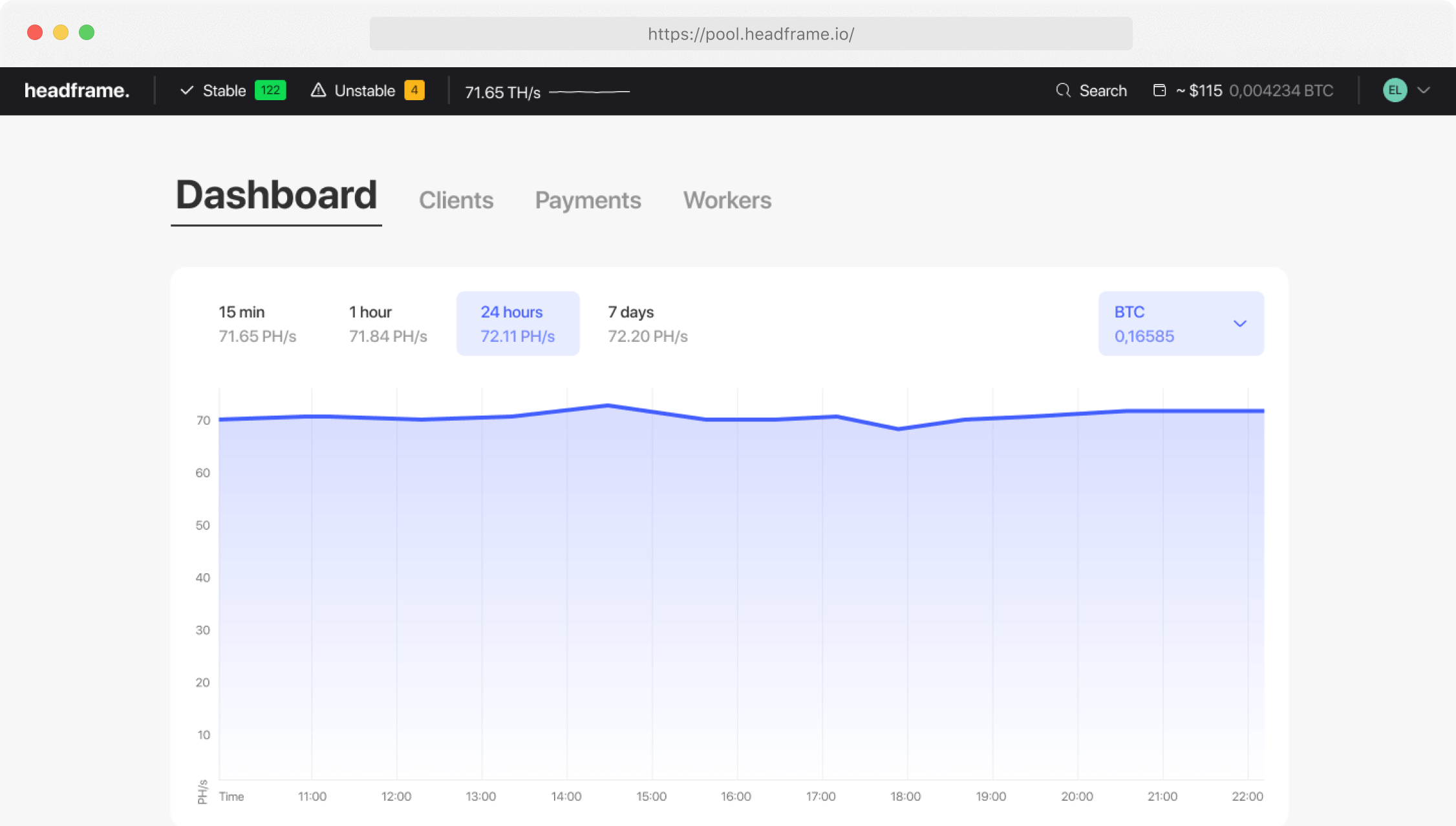Mining Pools and Blockchain: Evolution of Technologies
Mining pools play a crucial role in the cryptocurrency ecosystem by combining the efforts of numerous miners to more efficiently extract digital assets. As blockchain technologies have evolved, mining pools have also undergone significant changes, adapting to new challenges and opportunities. Let’s explore how mining pools contribute to the evolution of blockchain technologies, enhancing their efficiency, security, and sustainability, and examine the key stages and innovations that have influenced their development.
Earn more money with Headframe
Join a mining pool and get the best profitability in mining. Already more than 10,000 miners trust Headframe.
Early Stages of Cryptocurrency Mining
In the early stages of cryptocurrency development, mining was done individually. Each miner used their own computing power to solve complex mathematical problems, confirming transactions in the blockchain network. However, as the popularity and complexity of mining grew, the individual approach became less effective. This led to the emergence of mining pools, which allowed miners to combine their computing power to solve problems together. This approach significantly increased the chances of successfully finding blocks and receiving rewards.
Development of Combined Pools
The evolution of mining pools began with the creation of the first combined pools, offering miners the opportunity to share their computing power and rewards. This allowed miners to achieve a more stable income, even if their own computing power was relatively small. The emergence of pools also spurred the development of specialized equipment such as ASIC miners, which provided high performance and energy efficiency.
Implementation of New Algorithms and Methods
Over time, mining pools started to implement new algorithms and methods to improve the efficiency and security of their operations. One such method is the use of consensus algorithms like Proof of Work (PoW) and Proof of Stake (PoS). PoW requires significant computing power and energy to solve mathematical problems, while PoS is based on the amount of cryptocurrency held by the user, reducing energy consumption and increasing network sustainability. Mining pools began using hybrid models that combine elements of both approaches, improving overall efficiency and security.
Technological Innovations
Technological innovations have also played a crucial role in the evolution of mining pools. The introduction of advanced encryption methods and multi-level authentication significantly enhanced the security of mining operations. Modern data protection technologies help prevent unauthorized access and safeguard pool assets, which is particularly important given the growing number of cyber threats targeting cryptocurrency networks.
Energy Efficiency
Energy efficiency has become another critical aspect of mining pool development. As mining complexity increased, so did electricity costs. Mining pools began seeking ways to reduce energy consumption by using energy-efficient equipment and technologies, as well as transitioning to renewable energy sources. This not only reduced costs but also improved the environmental sustainability of mining operations, which is becoming increasingly important in today’s world.
Educational Initiatives
Educational initiatives supported by mining pools have also contributed to their evolution. Training miners in new methods and technologies has helped improve their skills and knowledge, leading to more efficient work. Educational programs and training sessions have helped pool participants better understand and use modern technologies to optimize their operations. This has promoted more responsible and informed participation in mining operations, enhancing their overall efficiency and stability.
Social and Environmental Responsibility
Social and environmental responsibility has become a vital aspect of mining pool activities. Supporting environmental initiatives and using renewable energy sources have garnered greater trust from participants and investors. Participation in social projects and support for local communities have also helped strengthen the reputation and sustainability of pools. This has fostered a more responsible and sustainable cryptocurrency ecosystem, which in turn has improved the stability and profitability of mining operations.
Partnerships and Collaboration
Partnerships and collaboration with other mining pools and companies have also played a significant role in the evolution of mining pools. Combining efforts with other organizations has facilitated the exchange of knowledge and resources, accelerating the development and implementation of new technologies. Partnership relationships have fostered the creation of a global ecosystem where innovations can quickly spread and adapt to various conditions. This has improved the overall efficiency and sustainability of mining operations.
Use of Artificial Intelligence (AI)
The use of artificial intelligence (AI) has significantly improved the management of mining pools. AI can analyze vast amounts of data in real-time, identifying patterns and trends that are difficult to detect manually. This allows for faster adaptation to network changes and optimization of operations for maximum performance. AI algorithms can also detect anomalies and potential threats, enabling prompt responses to cyber-attacks and other incidents. The application of AI helps improve the security, efficiency, and profitability of mining operations.
Transparency and Accountability
Transparency and accountability have also played a crucial role in the evolution of mining pools. Pools that provide transparent reports on income and expenses to their participants gain more trust and support. Financial transparency helps participants better understand how rewards are distributed and what costs are associated with pool operations. This promotes more equitable and informed participation in mining operations.
In conclusion, mining pools and blockchain technologies have undergone significant evolution, adapting to changes and challenges brought by the development of the cryptocurrency market. Continuous equipment updates, the implementation of advanced encryption methods, energy consumption optimization, cost management, revenue forecasting, AI use, educational initiatives, social and environmental responsibility, partnerships, and collaboration — all these aspects play a crucial role in ensuring the stability and profitability of mining operations. Understanding and applying these strategies help mining pools successfully adapt to market changes and achieve long-term success in the cryptocurrency industry.


